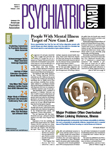Criteria for predicting conversion to psychosis among at-risk individuals has attained a level of accuracy equal to that of predictive criteria used in other areas of medicine.
Thirty-five percent of at-risk patients who met criteria according to the Structured Interview for Prodromal Syndromes (SIPS) converted to psychosis within two and a half years, according to a report in the January Archives of General Psychiatry. The study used pooled data on 291 patients at eight clinical research centers as part of the North American Prodrome Longitudinal Study.
The predictive power increased up to nearly 80 percent if patients meeting SIPS criteria also experienced combinations of five predictive symptoms: genetic risk (having a first-degree relative with psychotic illness), along with functional decline; unusual thought content; suspicion and paranoia; decline in social functioning; and any substance abuse.
“If you meet the criteria for SIPS, you have a 35 percent chance of developing psychosis within 30 months,” lead investigator Robert Heinssen, Ph.D., told Psychiatric News. “With drug abuse, that risk goes up to about 43 percent, and if you meet the SIPS plus all five unique predictive factors, it goes up to 79 percent.”
He is director of the Schizophrenia Spectrum Disorders Research Program in the Division of Adult Translational Research at the National Institute of Mental Health.
“What this means is that we now have clinical indicators that triple the predictive risk and narrow the window of risk from decades to two and a half years,” Heinssen said. “That really brings the prediction of psychosis into the realm of real-time clinical decision making.”
Heinnsen also emphasized the collaborative nature of the project, pooling data across eight sites, and the role of the federal government in providing funding as well as technical support and advice.
Prodrome Called 'Distinct Entity'
Psychiatrist Thomas McGlashan, M.D., a coauthor of the report, said the findings advance the idea of including the prodrome as a distinct diagnostic entity in DSM. And he said that prevention of severe mental illness is now a realizable goal for psychiatry.
“We can now reliably predict who is going to convert to psychosis using clinical criteria that every psychiatrist can recognize,” he said.“ It really means that the prodrome deserves its own category in the diagnostic manual. And it also means that psychiatrists will have to get serious about prevention, which is new territory for the profession.
“This is a new perspective for psychiatry,” McGlashan said.
In an editorial in the December 2007 Early Intervention in Psychiatry titled “The DSM Version of Schizophrenia May Be Harmful to Patients' Health,” McGlashan argued that new findings about early detection and intervention in schizophrenia are rendering the DSM's current emphasis on functional deterioration and duration of six months obsolete.
“Delaying the diagnosis of schizophrenia with a long-duration criterion and a requirement of deterioration may paradoxically foster stigma and alienation instead of protecting against it,” he wrote.“ Allowing unbridled psychosis to exist long enough to be sure of a diagnosis also allows the person's psychotic behavior and personal deterioration to identify him or her as 'crazy' by family, friends, school, work, and community. Delaying diagnosis protects against a false positive diagnosis and label but at the expense of neglecting or denying a dangerous clinical situation in the true positive patient—dangerous because of what can be wrought by the progressive and unchecked paralysis of higher mental functions.”
Combined Factors Increase Risk
In the Archives study, 291 at-risk patients were identified at baseline as meeting the criteria for the SIPS from the eight participating centers. They are Emory University; Harvard Medical School; University of California, Los Angeles; University of California, San Diego; University of North Carolina, Chapel Hill; University of Toronto; Yale University; and Zucker Hillside Hospital.
The SIPS criteria for a prodromal syndrome emphasize onset or worsening in the preceding 12 months of attenuated positive symptoms in one or more of five possible categories: unusual thought-content, suspicion/paranoia, perceptual anomalies, grandiosity, and disorganized communication. The instrument is used to determine whether the patient meets criteria for one or more of three possible prodromal syndromes: attenuated positive symptom syndrome, genetic risk and deterioration syndrome, and/or brief intermittent psychosis syndrome.
At two and a half years, 82 of the at-risk patients converted to psychosis, representing 35 percent of the cohort that was followed for the entire two and a half years. (Kaplan Meier Survival analysis, a statistical formula that adjusts for patients lost to follow-up, was used to ascertain the cumulative rate of conversion and the incidence rates of conversion within successive six-month epochs.)
Of the five unique predictive factors, genetic risk with decline in functioning was the most powerful: a patient who met SIPS criteria and also had a first-degree relative with schizophrenia and had experienced a decline in functioning had a 52 percent chance of converting to psychosis, according to the survey.
The other four unique predictive factors and their associated risks for conversion when added to the SIPS were unusual thought content (48 percent), decline in social functioning (46 percent), suspicion and paranoia (43 percent), and any substance abuse (43 percent).
But combinations of those factors raised the risk dramatically. Heinssen noted also that the SIPS criteria help to demarcate the line between pre-psychosis and psychosis. “If a person crosses that threshold, then antipsychotic medication should be initiated,” he said. “We know that the sooner treatment begins after onset, the better the functional outcome.”
He added that the findings now set the stage for neuroimaging and neurocognitive tests to “identify the mechanisms at the level of the brain relative to the unfolding over time of this movement from prodrome to psychosis.”
An abstract of “Prediction of Psychosis in Youth at High Clinical Risk: A Multi-Site Longitudinal Study in North America” is posted at<http://archpsyc.ama-assn.org/cgi/content/abstract/65/1/28>.“ TheDSMVersion of Schizophrenia May Be Harmful to Patients' Health” is posted at<www.blackwell-synergy.com/doi/full/10.1111/j.1751-7893.2007.00048.x>.▪
